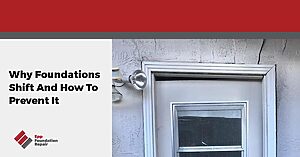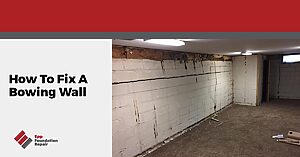Looking for information about sagging floor repair cost? If so, don’t hit that back button because you’ve landed on the right page. While a sagging floor may be problematic, there are repair solutions available.
The Good News Is Sagging Floors Can Be Repaired
If your home has a crawl space foundation and is experiencing sagging floors, don’t lose sleep over it because there are repair methods available. In this blog post, we’ll look at the causes of sagging floors in crawl space foundations and how to prevent them from happening again. We’ll also provide information on sagging floor repair cost and discuss different repair methods that can make your floors look as good as new. So if you’re dealing with a sagging floor, read on for more information.
Sagging Floor Repair Cost Will Depend On The Extent Of The Damage

The cost to repair a sagging floor will depend on the type and severity of the damage that’s causing the floor to sag. Depending on the extent of the problem, costs may involve replacing joists or other support structures, as well as labor costs associated with bringing everything back up to code. It’s helpful to understand what causes sagging floors and what repair methods are available to develop an informed plan for fixing them. With that in mind, it’s also important to know what steps can be taken upfront that could potentially prevent these types of issues from arising in the first place — tackling these preventive measures could save you quite a bit of money and hassle down the line.
Causes Of Sagging Floors In Crawl Space Foundations

The most common causes of sagging floors in crawl space foundations include the following:
- The support piers in the crawl space have settled – Water-saturated soil in the crawl space can cause the support piers to settle into the ground and become non-vertical.
- The wooden support piers in the crawl space have rotted – Wood rot can weaken the ability of the piers to support the floor.
- Deteriorated screw jacks – If screw jacks don’t have corrosion protection, they can deteriorate.
- The floor isn’t adequately supported – This might be because there aren’t enough support piers, beams, or joists.
- The beams or joists have problems – The beams or joists might be broken, affected by wood rot, or something else.
- There are no floor joists – Sometimes, a floor will be built over a crawl space using only a plywood subfloor installed over the beams and no joists. Since this isn’t enough support, the floor will eventually start to sag.
- Foundation settlement – If the floor is sagging toward the edges and not in the middle, the problem might be related to foundation settlement.
If you have a sagging floor, contact an experienced foundation repair professional to identify the underlying cause and then come up with the appropriate repair solution. However, arming yourself with knowledge about the possible causes of a sagging floor will help you understand more about any repair solution recommended by a professional.

Repair Methods For Sagging Floors
The chosen repair method to correct a sagging floor will depend on what’s causing the floor to sag. Some possible repair solutions for a sagging floor include the following:
If your support piers have settled…
If one or more support piers have settled, possible repair solutions include removing and replacing the settled piers or installing screw jacks. However, this alone isn’t going to solve the problem. If they settled because of soggy soil created by poor drainage around the foundation (common), that will need to be addressed so the new support piers won’t suffer the same fate.
If the wooden support piers have rotted…
Rotted wooden support piers can be replaced with new support piers or screw jacks.
If the screw jacks have deteriorated…
Screw jacks can deteriorate if they don’t have a coating to protect them against corrosion. The solution is to remove the deteriorated screw jacks and replace them with new screw jacks with corrosion protection.
For more information, see, What Is A Crawl Space Jack?
If the floor isn’t being adequately supported…
If the floor is sagging because of inadequate support, additional beams, joists, concrete footings with support piers, or screw jacks can be added.
If the beams or joists are rotten or broken…
Rotten or broken beams or joists can be replaced with new beams or joists.
If there are no floor joists, just a plywood subfloor…
Sometimes, there are no floor joists on top of the beams, just a plywood subfloor. Since this is usually inadequate support, the floor will eventually begin to sag. The solution is to add joists.
If there’s foundation settlement…
If the floor is sagging due to foundation settlement, underpinning using push or helical piers is the usual repair solution. For more information, see, What Is House Underpinning?
You Can Help Prevent Sagging Floors By Controlling Groundwater Around The Foundation
Prevention is key when it comes to sagging floors – or any foundation problem, for that matter. Since excess groundwater can be a major cause of sagging floors in a crawl space foundation, you can go a long way toward preventing a sagging floor by simply controlling groundwater around your foundation. Here are some ways to do that:
- If necessary, regrade your yard so it slopes away from the foundation – You don’t want groundwater draining toward the foundation.
- Don’t plant flowers and shrubs next to the house – When you water them, you’ll be adding moisture to the soil around the foundation.
- Clean your gutters regularly – Clogged gutters can cause water to spill over the side of your house and soak the ground around the foundation.
- Install downspout extensions – Downspout extensions will carry runoff at least 4 feet from the foundation before being released.
- Install a drain tile system – When it comes to foundation waterproofing, nothing beats a drain tile system. For more information, see How Does A Drain Tile System Work?

Will My Homeowners Insurance Cover Sagging Floor Repair?
Usually, homeowners insurance covers damage caused by something catastrophic such as an earthquake or flood. It doesn’t usually cover problems caused by settlement, problems with support piers in a crawl space, etc.
If You Have A Sagging Floor, Call A Professional Today
If your home has a sagging floor issue, don’t wait to get it fixed. Leaving a sagging floor unchecked can lead to further structural problems. A professional foundation repair contractor can quickly diagnose the issue and recommend an appropriate repair solution. In some cases, the only cost might be replacing or reinforcing existing beams or joists, while more severe problems may require more costly repairs. Not only that, a foundation repair professional can advise on how to maintain the integrity of your floors and prevent sagging in the future. So, don’t delay – contact a reliable foundation repair contractor today for more information about repairing your sagging floor.
If you need sagging floor repair and are in our Nebraska, Iowa, Kansas, or Missouri service area, contact us today for an evaluation and repair estimate.







